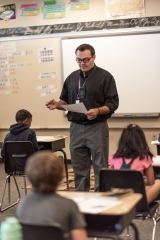-
Category 1
Selected in 2021
-
Grades: k - 4
School Setting: suburban
Town Population: 61,000
Student Enrollment: 291
Student Demographics:
Black/African American: 3%
Teacher/Student Ratio: 1:19.3
White/Caucasian: 79%
Hispanic: 14%
Hawaiian/Pacific Islander: 0%
Asian: 2%
Native American: 2%
Other: 0%
% Reduced Lunch: 35%
% ELL Learners: 1%
Founded: 1984 -
PRINCIPAL:
Sean Gorman -
CONTACT:
2204 Plain View Road
Cheyenne, WY 82009
307-771-2606
sean.gorman@laramie1.org
Anderson Elementary School
Cheyenne, WY
The easy-to-implement techniques from TLaC 2.0 were almost immediately adopted and effectively implemented in many of our classrooms."
- 1. Tell us about your school’s success.
- During the 2018-2019 school year, Anderson was the only neighborhood school in our district to be rated, "Exceeding Expectations" on the School Performance Report (SPR) from the Wyoming Department of Education (WDE). Unfortunately, we were not able to take the state assessment during the 2019-2020 school year because of district-wide school closures throughout the spring. However, we were able to test again during the 2020-2021 school year, and our percent proficient went up 13 percentage points from the 18-19 school year. We were very proud of our "Exceeding Expectations" rating, so you can imagine how excited we were for our students when 13 percent more of them tested proficient/advanced in 20-21!
- 2. Talk about the greatest contributing factor(s) that promoted positive change in your school.
-
Three main factors contributed to the success of our students.
1. Highly-effective teachers who are dedicated to their students and their success; you can't have a great school without great teachers!
2. Parents who partner with our school and support the education of their children
3. A crystal-clear focus on the "influences on learning" from the research base that have the highest effect size on student learning. - 3. How has ESEA funding supported the school's success?
- Extended day reading and math groups were offered to several students at our school. We prioritized students that were part of what the WDE calls our "Equity" group. These are students who scored in the lowest 25th percentile (Below Basic) on reading and/or math. Likely because of the extra learning opportunities made possible by ESEA funding, many of the students in this group made very strong academic growth. Consequently, they had quite high growth percentiles. These individual student growth percentiles had a very positive effect on both our "Equity" score and our 'Growth" score (both calculated as a mean growth percentile) from the WDE.
- 4. What professional development activities were used to improve teaching and learning?
- Our staff has spent many years researching and applying the most effective instructional techniques and strategies. We started several years ago with Doug Lemov's Teach Like a Champion 2.0 (TLaC 2.0) and John Hattie's Visible Learning. The easy-to-implement techniques from TLaC 2.0 were almost immediately adopted and effectively implemented in many of our classrooms. Researching Hattie's work allowed us to narrow our school-wide focus to two main areas: "Teacher-Student Relationships" -- d = 0.72 -- and "Teacher Clarity" -- d = 0.75. This focus on teacher clarity later evolved into what we call the "Formative Teaching Cycle," which is a series of influences that range in effect size from d = 0.72 - d = 1.44.
- 5. Talk about the cultural shift leading up to your school's success.
- Our focus on student-teacher relationships had a significant influence on not only the students at our school, but also their teachers and our staff. Using resources like Stephen Covey's The 7 Habits of Highly Effective People, Jim Collins' Good to Great, and even Dale Carnegie's How to Win Friends and Influence People may seem to be curious choices for a school, but the learning procured from these gems has been almost tangible on our culture. Shifting a culture can be arduous work, and we have had a lot of turnover among teachers and Paras, but now when we have an opening, we have excellent candidates apply, the type of teachers that will fit with our new culture, which is focused on working hard, having a lot of fun, and learning more than students could have ever imagined!
- 6. How has community involvement strengthened your success?
- Our parent community is fantastic! We love them and their support of their children's education! We have tried to intentionally partner with parents, including them in our most important decisions and asking for their help in school and/or at home depending on their busy work schedules.
Stats
-
Category 1
Selected in 2021
-
Grades: k - 4
School Setting: suburban
Town Population: 61,000
Student Enrollment: 291
Student Demographics:
Black/African American: 3%
Teacher/Student Ratio: 1:19.3
White/Caucasian: 79%
Hispanic: 14%
Hawaiian/Pacific Islander: 0%
Asian: 2%
Native American: 2%
Other: 0%
% Reduced Lunch: 35%
% ELL Learners: 1%
Founded: 1984 -
PRINCIPAL:
Sean Gorman -
CONTACT:
2204 Plain View Road
Cheyenne, WY 82009
307-771-2606
sean.gorman@laramie1.org








